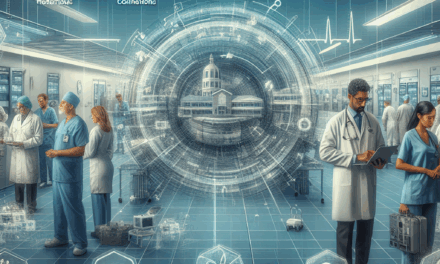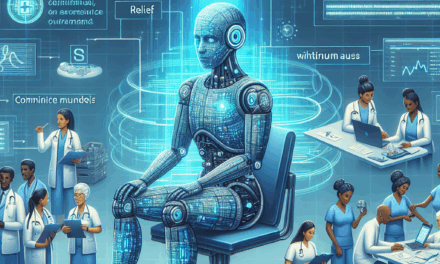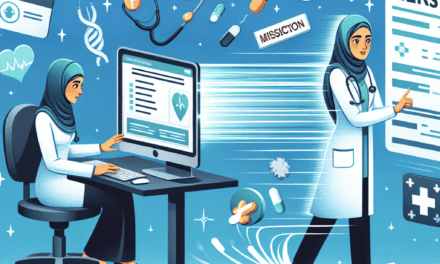The Impact of Medical Technology on Healthcare Transformation
In recent years, the healthcare landscape has undergone a significant transformation, largely driven by advancements in medical technology. From telemedicine to artificial intelligence (AI), these innovations have not only improved patient outcomes but have also redefined the way healthcare is delivered. This article explores the multifaceted impact of medical technology on healthcare transformation, focusing on five key areas: telemedicine, electronic health records (EHRs), wearable technology, artificial intelligence, and robotics in surgery.
1. Telemedicine: Bridging the Gap in Healthcare Access
Telemedicine has emerged as a revolutionary approach to healthcare delivery, particularly in the wake of the COVID-19 pandemic. By enabling remote consultations between patients and healthcare providers, telemedicine has made healthcare more accessible, especially for those in rural or underserved areas.
One of the most significant advantages of telemedicine is its ability to reduce barriers to access. Patients no longer need to travel long distances to see a specialist, which can be particularly challenging for those with mobility issues or chronic conditions. According to a report by the American Telemedicine Association, telemedicine visits increased by over 154% in March 2020 compared to the previous year, highlighting its growing acceptance among patients and providers alike.
Moreover, telemedicine has proven to be a cost-effective solution for both patients and healthcare systems. By reducing the need for in-person visits, telemedicine can lower transportation costs and minimize time off work for patients. For healthcare providers, it can lead to increased efficiency and reduced overhead costs associated with maintaining physical office spaces.
However, the rapid adoption of telemedicine has also raised concerns regarding data security and patient privacy. The Health Insurance Portability and Accountability Act (HIPAA) sets strict guidelines for the protection of patient information, and telemedicine platforms must comply with these regulations to ensure patient confidentiality. Additionally, there is a need for robust cybersecurity measures to protect against data breaches.
Despite these challenges, the future of telemedicine looks promising. As technology continues to evolve, we can expect to see improvements in video conferencing quality, integration with EHRs, and the development of specialized telehealth platforms tailored to specific medical fields.
2. Electronic Health Records (EHRs): Streamlining Patient Information
Electronic Health Records (EHRs) have transformed the way patient information is stored, accessed, and shared among healthcare providers. By digitizing patient records, EHRs facilitate better coordination of care, reduce errors, and enhance patient safety.
One of the primary benefits of EHRs is their ability to provide a comprehensive view of a patient’s medical history. Healthcare providers can access vital information such as allergies, medications, and previous treatments in real-time, allowing for more informed decision-making. A study published in the Journal of the American Medical Association found that EHRs can reduce medication errors by up to 50%, significantly improving patient safety.
Additionally, EHRs enable seamless communication between different healthcare providers. For instance, if a patient is referred to a specialist, the specialist can quickly access the patient’s EHR to review their medical history and treatment plan. This level of coordination is crucial for managing chronic conditions that require input from multiple healthcare professionals.
However, the implementation of EHRs is not without its challenges. Many healthcare organizations face significant costs associated with transitioning from paper-based systems to EHRs. Furthermore, the usability of EHR systems can vary widely, with some providers reporting frustration with complex interfaces that hinder rather than enhance their workflow.
Despite these hurdles, the long-term benefits of EHRs are undeniable. As more healthcare organizations adopt EHR systems, we can expect to see improved patient outcomes, reduced healthcare costs, and enhanced data analytics capabilities that can inform public health initiatives.
3. Wearable Technology: Empowering Patients in Self-Management
Wearable technology has gained immense popularity in recent years, with devices such as smartwatches and fitness trackers becoming commonplace. These devices not only track physical activity but also monitor vital signs, providing users with valuable insights into their health.
One of the most significant impacts of wearable technology is its ability to empower patients in self-management. For instance, individuals with chronic conditions such as diabetes can use wearable devices to monitor their blood glucose levels in real-time. This immediate feedback allows patients to make informed decisions about their diet and medication, ultimately leading to better health outcomes.
Moreover, wearable technology can facilitate early detection of health issues. Many devices are equipped with sensors that can detect irregular heart rhythms or changes in physical activity levels, prompting users to seek medical attention when necessary. A study published in the journal Circulation found that wearable devices could accurately detect atrial fibrillation in patients, potentially preventing serious complications such as stroke.
However, the widespread adoption of wearable technology also raises questions about data privacy and security. As these devices collect sensitive health information, it is crucial for manufacturers to implement robust security measures to protect user data. Additionally, there is a need for clear regulations regarding the use of health data collected by wearable devices.
Looking ahead, the integration of wearable technology with telemedicine and EHRs could further enhance patient care. For example, healthcare providers could access data from wearable devices during virtual consultations, allowing for more personalized treatment plans.
4. Artificial Intelligence: Revolutionizing Diagnostics and Treatment
Artificial Intelligence (AI) is transforming the healthcare industry by enhancing diagnostics, personalizing treatment plans, and improving operational efficiency. AI algorithms can analyze vast amounts of data quickly and accurately, enabling healthcare providers to make more informed decisions.
One of the most promising applications of AI in healthcare is in the field of diagnostics. For instance, AI-powered imaging tools can analyze medical images such as X-rays and MRIs to detect abnormalities with a level of accuracy that rivals human radiologists. A study published in Nature found that an AI algorithm was able to detect breast cancer in mammograms with a higher accuracy rate than human radiologists, potentially leading to earlier detection and treatment.
AI is also being used to personalize treatment plans based on individual patient data. By analyzing genetic information, medical history, and lifestyle factors, AI algorithms can identify the most effective treatment options for each patient. This approach, known as precision medicine, has the potential to improve treatment outcomes and reduce adverse effects.
Furthermore, AI can enhance operational efficiency within healthcare organizations. For example, AI-powered chatbots can handle routine inquiries from patients, freeing up staff to focus on more complex tasks. Additionally, AI can optimize scheduling and resource allocation, reducing wait times and improving patient satisfaction.
However, the integration of AI in healthcare also raises ethical concerns. Issues such as algorithmic bias and the potential for job displacement among healthcare workers must be addressed to ensure that AI is used responsibly and equitably.
As AI technology continues to evolve, we can expect to see even more innovative applications in healthcare, ultimately leading to improved patient care and outcomes.
5. Robotics in Surgery: Enhancing Precision and Minimizing Invasiveness
Robotic surgery has revolutionized the field of surgery by enhancing precision, minimizing invasiveness, and improving recovery times. Robotic surgical systems, such as the da Vinci Surgical System, allow surgeons to perform complex procedures with greater accuracy and control.
One of the primary benefits of robotic surgery is its ability to minimize tissue damage. Traditional open surgery often requires large incisions, leading to longer recovery times and increased risk of complications. In contrast, robotic surgery typically involves smaller incisions, resulting in less pain and faster recovery for patients. A study published in the Journal of Robotic Surgery found that patients who underwent robotic-assisted surgery experienced significantly shorter hospital stays compared to those who had traditional surgery.
Moreover, robotic systems provide surgeons with enhanced visualization and dexterity. The 3D high-definition camera and articulated instruments allow for greater precision in delicate procedures, such as prostatectomies and cardiac surgeries. This level of control can lead to improved surgical outcomes and reduced rates of complications.
However, the adoption of robotic surgery is not without its challenges. The high cost of robotic surgical systems can be a barrier for many healthcare organizations, particularly smaller hospitals. Additionally, there is a learning curve associated with operating robotic systems, necessitating specialized training for surgeons.
Despite these challenges, the future of robotic surgery looks promising. As technology continues to advance, we can expect to see the development of more affordable and user-friendly robotic systems, further expanding the applications of robotic surgery in various medical fields.
Conclusion: The Future of Healthcare Transformation
The impact of medical technology on healthcare transformation is profound and far-reaching. From telemedicine to robotics, these innovations are reshaping the way healthcare is delivered, improving patient outcomes, and enhancing operational efficiency. As we look to the future, it is essential for healthcare organizations to embrace these technologies while addressing the associated challenges, such as data privacy and ethical considerations.
In summary, the key takeaways from this exploration of medical technology’s impact on healthcare transformation include:
- Telemedicine has improved access to healthcare, particularly for underserved populations.
- EHRs streamline patient information management, enhancing coordination of care and patient safety.
- Wearable technology empowers patients in self-management and early detection of health issues.
- AI revolutionizes diagnostics and treatment personalization while improving operational efficiency.
- Robotic surgery enhances precision and minimizes invasiveness, leading to better surgical outcomes.
As medical technology continues to evolve, it holds the potential to further transform healthcare, making it more accessible, efficient, and patient-centered. The journey towards a technologically advanced healthcare system is ongoing, and its success will depend on collaboration among healthcare providers, technology developers, and policymakers.




